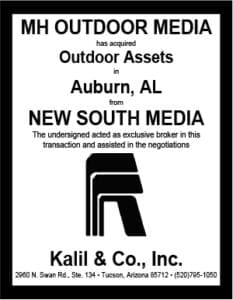
Billboard Insider recently received a legal question from a reader, asking if the following municipal ordinance provision was arbitrary, unconstitutional, or otherwise illegal:
6.604 Off-Premises Advertising Signs and Billboards: The intent of this Section 6.604 is to limit the number, size and location of off-premises advertising signs and billboards to reduce visual clutter in the Township, prevent the distraction of drivers, and maintain the character of the community. Off-premises advertising signs and billboards, as defined in Article II, may be erected and maintained only in C-1 and M-1 Zone Districts in accord with the requirements of this Section 6.604 and all other applicable requirements of this Zoning Ordinance, and applications for such signs shall be considered conditional uses
(b) Exchange – The erection of an off-premises advertising sign or billboard shall not be permitted unless an off-premises advertising sign or billboard of equal or greater size is removed from another location in the Township.
The reader is especially upset because the “exchange” provision seems to be practically available only to one competitor in the market, which has a sufficient number of dispensable billboards to remove in exchange for the permission to erect new billboards. Thus, the reader feels aggrieved because he doesn’t own the type of inventory that will afford him the same opportunity under this ordinance to secure and operate new billboards like his competitor.
I have also been asked questions like this previously from clients under different scenarios. Under the ordinance referenced by the reader and these other situations, the common element for these so-called “cap and replacement” or “exchange” ordinances is that the government caps or diminishes the number of billboards in the jurisdiction, in exchange for the perceived concession of permitting erection of new billboards, or conversion of wood structures to steel, or static illumination to digital. And, as the reader observed, there is inevitably in every jurisdiction at lease one competitor who owns more billboards deemed expendable enough to remove in exchange for these types of concessions, thereby exacerbating his competitive advantage even further.
Unfortunately for the reader, just because an ordinance seems unfair doesn’t mean it’s illegal. Indeed, the stated purpose and intent in these cap and replacement or exchange ordinances is the reduction in the number of billboards, as expressly articulated in Section 6.604 of the ordinance above. These objectives have been considered sufficiently legitimate governmental interests to justify the exercise of municipal police power. And, as far as the cities with these types of ordinances, as well as the courts considering them are concerned, it makes little difference that some competitors are more favorably positioned to utilize these ordinances than others.
Having noted these general principles, however, a city is obviously prohibited from enacting and enforcing its ordinances in an arbitrary, capricious, unconstitutional, or otherwise illegal manner. For example, equal protection under the laws is required by the Fourteenth Amendment, but it is not an effective argument for the reader, as billboard competitors are not accorded the same rights of equal treatment as the protected classes of race, national origin, or religion under the Constitution. Similarly, taking of private property without compensation is prohibited by the Fifth Amendment, but participation in these ordinances and programs is voluntary and constitutional, as the competitor can readily decline removal of his billboards in exchange for the proffered concessions. The closest situation I’ve seen where a court prevented a city from enforcing an ordinance that seemed to confer unfair advantages to particular competitors is Summit Media vs City of Los Angeles. This 2013 decision by the California Court of Appeals involved a settlement between Clear Channel and CBS Outdoor and Los Angeles, under which these two billboard companies were permitted to digitize and retain certain billboards that would have otherwise been prohibited under the Los Angeles ordinance. A third competitor, Summit, challenged the settlement, arguing that the settlement agreement was illegal. The Court agreed, explaining “the cases are clear that an agreement to circumvent applicable zoning laws is invalid and unenforceable. That is precisely what happened here; the settlement agreement exempted [the competitors] from prohibitions in the 2002 sign ban and other regulations…An agreement is ultra vires when it contractually exempts settling parties from ordinances and regulations that apply to everyone else and would, except for the agreement, apply to the settling parties.” Of course, the reader’s situation is quite different, since the municipality actually passed an ordinance consistent with its stated legitimate governmental purpose, and hasn’t attempted to exempt any competitors from its enforcement.
In this situation, I suspect the competitor was experienced in lobbying, and influential in the passage of this cap and replacement or exchange ordinance. Likewise, the lesson for the reader is to be more proactive in municipal ordinance making and lobbying himself in the future.
[wpforms id=”9787″]
Paid Advertisement

















